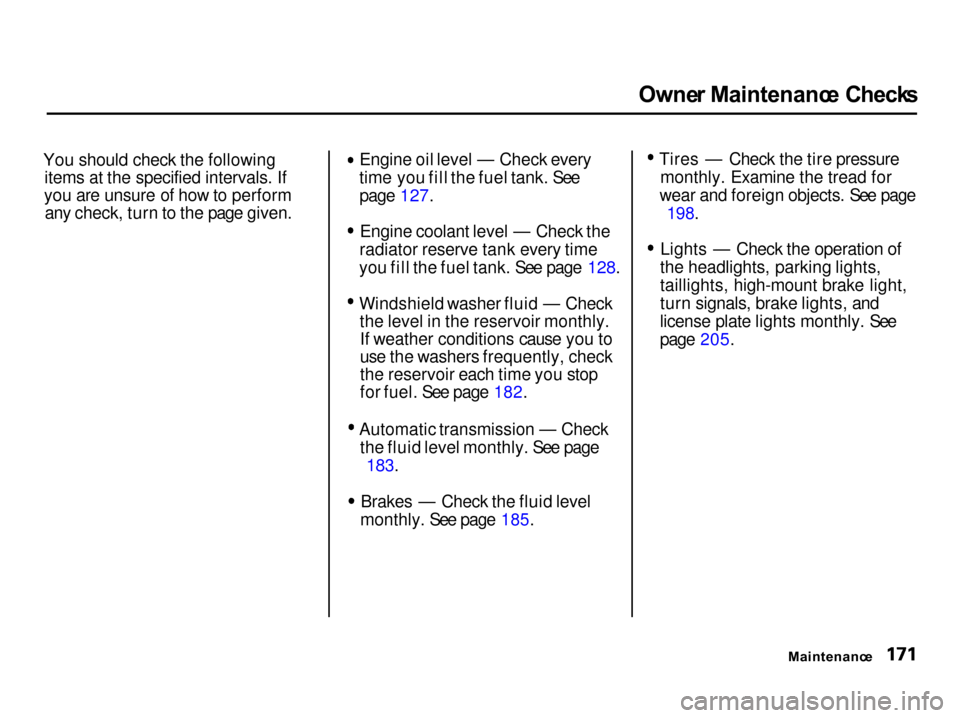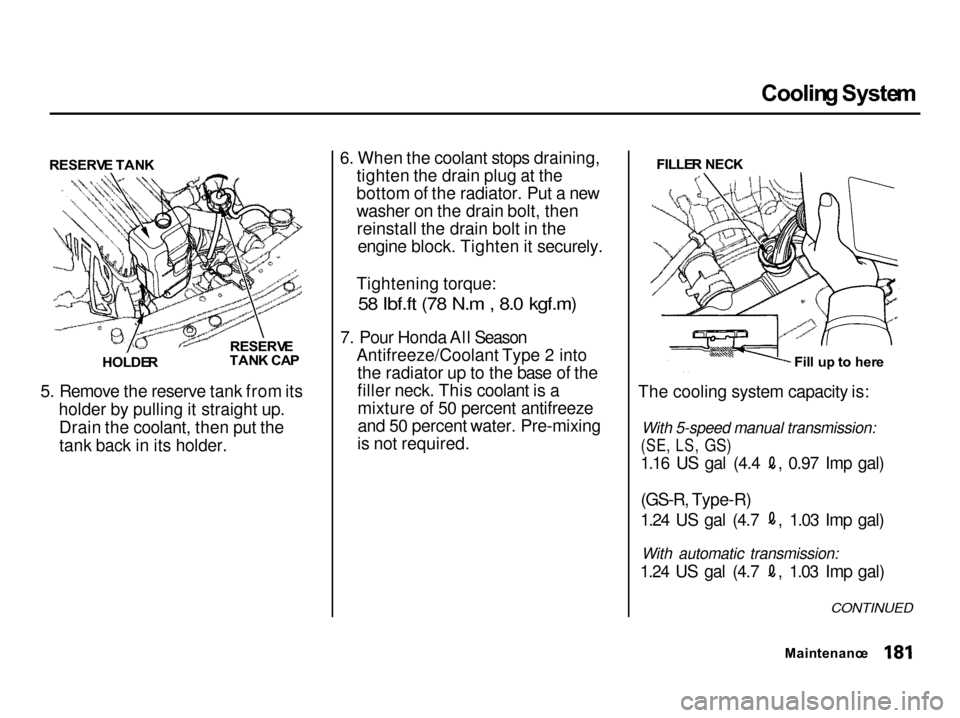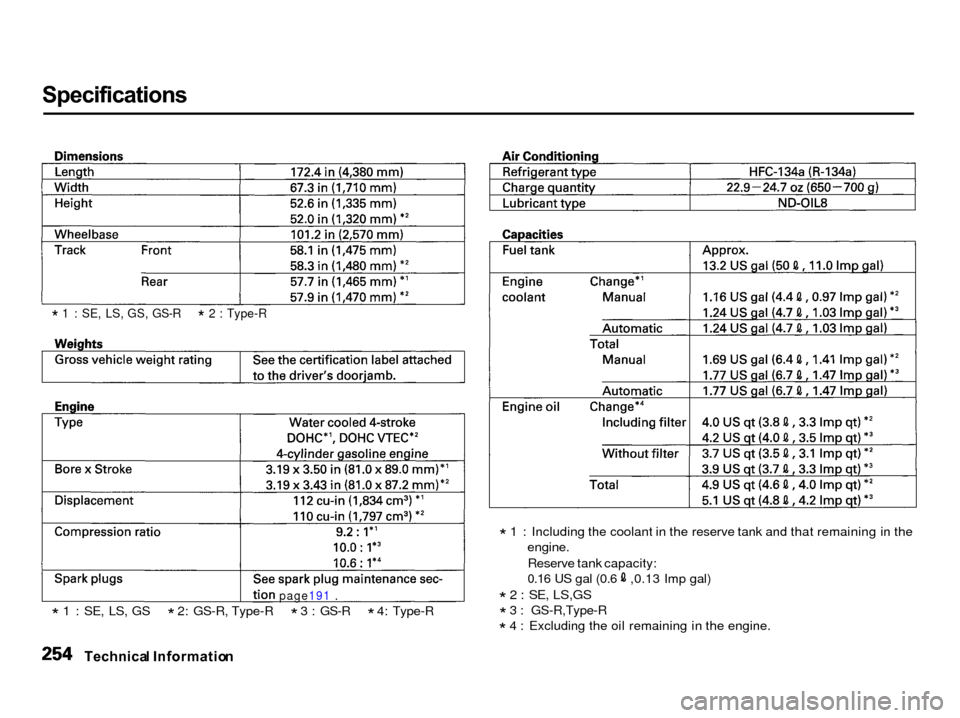engine coolant Acura Integra 2001 User Guide
[x] Cancel search | Manufacturer: ACURA, Model Year: 2001, Model line: Integra, Model: Acura Integra 2001Pages: 285, PDF Size: 3.79 MB
Page 174 of 285

Owne
r Maintenanc e Check s
You should check the following items at the specified intervals. If
you are unsure of how to perform any check, turn to the page given. Engine oil level — Check every
time you fill the fuel tank. See page 127. Engine coolant level — Check the
radiator reserve tank every time
you fill the fuel tank. See page 128. Windshield washer fluid — Check
the level in the reservoir monthly.If weather conditions cause you to
use the washers frequently, check
the reservoir each time you stop
for fuel. See page 182. Automatic transmission — Check
the fluid level monthly. See page
183.
Brakes — Check the fluid level
monthly. See page 185. Tires — Check the tire pressure
monthly. Examine the tread for
wear and foreign objects. See page
198.
Lights — Check the operation of
the headlights, parking lights,
taillights, high-mount brake light,
turn signals, brake lights, and
license plate lights monthly. See
page 205.
Maintenance
Page 181 of 285

Coolin
g Syste m
Addin g Engin e Coolan t
RESERV E TAN K
If the coolant level in the reserve
tank is at or below the MIN line, add coolant to bring it up to the MAX line.
Inspect the cooling system for leaks.
This coolant should always be a mixture of 50 percent antifreeze and50 percent water. Never add straight
antifreeze or plain water. Always use Honda All Season
Antifreeze/Coolant Type 2. This coolant is pre-mixed with 50 percent
antifreeze and 50 percent water. Itdoes not require any additional
mixing. If it is not available, you may
use another major-brand non-silicate coolant as a temporary replacement.
Make sure it is a high-quality coolant
recommended for aluminum engines. However, continued use of any non-
Honda coolant can result incorrosion, causing the coolingsystem to malfunction or fail. Have
the cooling system flushed and refilled with Honda antifreeze/
coolant as soon as possible. If the reserve tank is completely
empty, you should also check the
coolant level in the radiator.
Maintenanc e
MI
N MAX Removing the radiator cap
while the engine is hot can cause the coolant to spray out,
seriously scalding you.
Always let the engine and radiator cool down before
removing the radiator cap.
Page 182 of 285

Coolin
g Syste m
1. Make sure the engine and radiator are cool.
2. Turn the radiator cap counter- clockwise, without pressing down
on it, until it stops. This relieves
any pressure remaining in the
cooling system.
3. Remove the radiator cap by pushing down and turning
counterclockwise.
4. The coolant level should be up tothe base of the filler neck. Addcoolant if it is low.
5. Put the radiator cap back on. Tighten it fully. 6. Pour coolant into the reserve tank.
Fill it to halfway between the MAX
and MIN marks. Put the cap backon the reserve tank.
CONTINUED
Maintenanc e
RESERV
E TAN K
RADIATO
R CA P
Page 183 of 285

Coolin
g Syste m
Do not add any rust inhibitors or
other additives to your car's cooling system. They may not be compatible
with the coolant or engine compo-
nents.
Replacin g Engin e Coolan t
The cooling system should be completely drained and refilled with
new coolant according to the timeand distance recommendations in
the maintenance schedule. Only use Honda All Season Antifreeze/Coolant Type 2.
Draining the coolant requires access
to the underside of the car. Unless
you have the tools and knowledge,
you should have this maintenance done by a skilled mechanic. 1. Turn the ignition ON (II). Slide
the heater temperature control
lever to maximum heat. Turn theignition off.
2. Open the hood. Make sure the engine and radiator are cool to the
touch.
3. Remove the radiator cap. 4. Loosen the drain plug on the
bottom of the radiator. The
coolant will drain through thesplash guard. Remove the drain
bolt and washer from the engine
block.
Maintenanc e
DRAI
N PLU G
DRAI
N
BOL T
Page 184 of 285

Coolin
g Syste m
5. Remove the reserve tank from its holder by pulling it straight up.Drain the coolant, then put the
tank back in its holder. 6. When the coolant stops draining,
tighten the drain plug at the
bottom of the radiator. Put a new
washer on the drain bolt, thenreinstall the drain bolt in the engine block. Tighten it securely.
Tightening torque:
58 Ibf.ft (78 N.m , 8.0 kgf.m)
7. Pou
r Honda All Season
Antifreeze/Coolant Type 2 into the radiator up to the base of the
filler neck. This coolant is amixture of 50 percent antifreeze
and 50 percent water. Pre-mixing
is not required. The cooling system capacity is:
With 5-speed manual transmission:
(SE,
LS,
GS)
1.16 US gal (4.4 , 0.97 Imp gal)
(GS-R, Type-R
)
1.24 US gal (4.7 , 1.03 Imp gal)
With automatic transmission:
1.24 US gal (4.7 , 1.03 Imp gal)
Maintenanc
e
CONTINUED
Fil
l u p
t
o her e
RESERV
E
TAN K CA P
HOLDE R
RESERV
E TAN K
FILLE
R NEC K
Page 185 of 285

Coolin
g System , Windshiel d Washer s
8. Start the engine and let it run for about 30 seconds. Then turn off
the engine.
9. Fill the radiator with coolant up to the base of the filler neck.
10. Fill the reserve tank to the MAX mark. Install the reserve tank cap.
11. Install the radiator cap, and tighten it to the first stop.
12. Start the engine and let it run until the radiator cooling fan comes on
at least twice. Then stop the
engine.
13. Remove the radiator cap. Fill the radiator with coolant up to thebase of the filler neck. 14. Start the engine and hold it at
1,500 rpm until the radiator fan
comes on. Turn off the engine.
Check the coolant level in the
radiator and add coolant if needed.
15. Install the radiator cap, and tighten it fully.
16. If necessary, fill the reserve tank to the MAX mark. Install the
reserve tank cap. Windshiel
d Washer s
Check the level in the windshield
washer reservoir at least monthly during normal usage. In bad weather,
when you use the washers often, check the level every time you stop
for fuel. This reservoir supplies the
windshield and rear window washers.
Maintenanc e
Page 239 of 285

I
f You r Engin e Overheat s
The pointer of your car's tempera- ture gauge should stay in the mid-range under most conditions. It may
go higher if you are driving up a longsteep hill on a very hot day. If it
climbs to the red mark, you should determine the reason.
Driving with the temperature gauge
pointer at the red mark can cause serious damage to your engine.
Your car can overheat for several
reasons, such as lack of coolant or a
mechanical problem. The only
indication may be the temperature
gauge climbing to or above the red
mark. Or you may see steam or spray coming from under the hood.
In either case, you should take
immediate action.
1. Safely pull to the side of the road. Put the transmission in Neutral or
Park and set the parking brake.
Turn off the heating and cooling system and all other accessories.
Turn on the hazard warning indicators. 2. If you see steam and/or spray
coming from under the hood, turnoff the engine.
3. If you do not see steam or spray, leave the engine running and
watch the temperature gauge. If the high heat is due to overloading (climbing a long, steep hill on a
hot day with the A/C running, for example), the engine should start
to cool down almost immediately. If it does, wait until the tempera-
ture gauge comes down to the mid-
point then continue driving.
4. If the temperature gauge stays at the red mark, turn off the engine.
5. Wait until you see no more signs of steam or spray, then open the
hood.
Takin g Car e o f th e Unexpecte d
Steam and spray from an
overheated engine can
seriously scald you.
Do not open the hood if steam
is coming out.
NOTIC
E
Page 240 of 285

I
f You r Engin e Overheat s
6. Look for any obvious coolant leaks, such as a split radiator hose.
Everything is still extremely hot, so use caution. If you find a leak, it
must be repaired before you
continue driving (see Emergenc y
Towin g on page 248).
7. If you don't find an obvious leak, check the coolant level in the
radiator reserve tank (see page128). If the level is below the
MIN mark, add coolant to halfway
between the MIN and MAX marks.
8. If there was no coolant in the reserve tank, you may also have toadd coolant to the radiator. Let the
engine cool down until the pointer
reaches the middle of the tempera-
ture gauge, or lower, before check-
ing the radiator.
9. Using gloves or a large heavy
cloth, turn the radiator capcounterclockwise, without pushingdown, to the first stop. This
releases any remaining pressure in
the cooling system. After the
pressure releases, push down on
the cap and turn it until it comes off.
10. Start the engine and set the
temperature control lever tomaximum. Add coolant to the
radiator up to the base of the filler
neck. If you do not have the
proper coolant mixture available,
you can add plain water.
Remember to have the cooling
system drained and refilled with
the proper mixture as soon as you
can.
11. Put the radiator cap back on tightly. Run the engine and watch
the temperature gauge. If it goes
back to the red mark, the engine
needs repair. (See Emergenc y
Towin g on page 248.)
12. If the temperature stays normal, check the coolant level in theradiator reserve tank. If it has
gone down, add coolant to the
MAX mark. Put the cap back on
tightly.
Takin g Car e o f th e Unexpecte d
Removing the radiator cap
while the engine is hot can
cause the coolant to spray out,
seriously scalding you.
Always let the engine and radiator cool down before
removing the radiator cap.
Page 257 of 285

Specifications
Technical Informatio n
*
1
: Including the coolant in the reserve tank and that remaining in the
engine.
Reserve tank capacity: 0.16 US gal (0.6 ,0.13 Imp gal)
* 2: SE, LS,GS
* 3: GS-R,Type-R
* 4: Excluding the oil remaining in the engine.
*
1 : SE, LS, GS
* 2: GS-R, Type-R
* 3 : GS-R
* 4: Type-R
*
1 : SE, LS, GS, GS-R
* 2 : Type-R
page191 .
Page 277 of 285

Inde
x
Capacities Chart.................... 254, 255
Carbon Monoxide Hazard.............. 49
Cargo Area Cover............................ 83
Carrying Cargo.............................. 132
Cassette Player
Care............................................. 118
Operation.................................... 115
CAUTION, Explanation of............... ii
CD Changer.................................... 111
CD Player........................................ 109
Certification Label......................... 252
Chains............................................. 204
Changing Oil
How to......................................... 175
When to....................................... 162
Changing a Flat Tire..................... 227
Changing Engine Coolant............. 180
Charging System Indicator.... 55, 239
Checklist, Before Driving............. 136
Child Safety...................................... 21
Child Seats........................................ 26
Tether Anchorage Points........... 41
Cleaner Element, Air..................... 188
Cleaning
Aluminum Wheels..................... 219
Antenna....................................... 218Carpeting.................................... 220
Exterior....................................... 218
Fabric.......................................... 221
Interior........................................ 220
Leather........................................ 221
Seat Belts.................................... 221
Vinyl............................................221
Windows..................................... 222
Clock, Setting the............................ 88
Clutch Fluid.................................... 185
Code, Audio System...................... 119
CO in the Exhaust......................... 260 Cold Weather, Starting in............. 137
Compact Spare............................... 226
Console Compartment.................... 90
Consumer Information*................ 266
Controls, Instruments and.............. 51
Coolant
Adding......................................... 178
Checking..................................... 128
Proper Solution.......................... 178
Replacing.................................... 180
Temperature Gauge.................... 59
Corrosion Protection..................... 223
Crankcase Emissions Control
System......................................... 260
Cruise Control Operation............... 67
Customer Relations Office........... 266
DANGER, Explanation of................. ii
Dashboard.................................... 2, 52
Daytime Running Lights................. 62
Defects, Reporting Safety............. 269
Defog and Defrost......................... 100
Defogger, Rear Window................. 65
Dimensions..................................... 254 Dimming the Headlights................ 62
Dipstick Automatic Transmission........... 183
Engine Oil................................... 127
Directional Signals........................... 63
Disc Brake Wear Indicators......... 145
Disposal of Used Oil...................... 177
Doors Locking and Unlocking............... 75
Power Door Locks....................... 75
DOT Tire Quality Grading........... 256